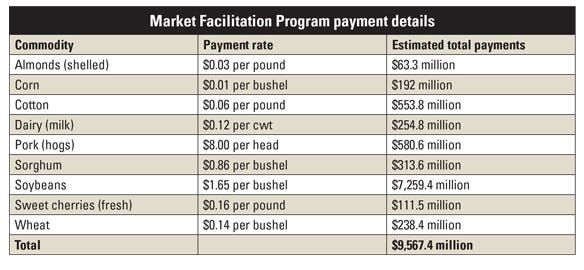January 3, 2019

In mid-December, USDA announced that the second and final payment for the Market Facilitation Program would be made. Producers only need to sign up once for the MFP to be eligible for the first and second payments. The MFP sign-up period began in September and runs through Jan. 15, with information and instructions provided at farmers.gov/mfp.
Producers must complete and sign Part D of FSA form CCC-910 by Jan. 15. However, they have until May 1 to certify 2018 actual production at their local USDA Farm Service Agency office. The MFP provides payments to almond, corn, cotton, dairy, hog, sorghum, soybean, fresh sweet cherry and wheat producers who have been significantly affected by foreign governments’ actions resulting in the loss of traditional exports. The MFP is established under the authority of the Commodity Credit Corp. CCC Charter Act and is under the administration of FSA.
Payment on remaining 50% of production
For farmers who have completed harvest, already applied and certified their 2018 production, a second payment now will be issued on the remaining 50% of the producer’s total production, multiplied by the MFP rate for the specific commodity. These MFP payments will be taxable in the year received.
Applicants must have an ownership interest, be actively engaged in farming, have an average adjusted gross income (AGI) of less than $900,000 for the 2014-16 tax years and have complied with regulations on highly erodible land and wetland conservation.
Payment rates were determined by USDA, based on its estimates of trade disruptions for the individual commodities. For all commodities covered, the payments will be made on 50% of eligible production for the first payment. The second payment for the remaining 50% now will be made. The table below shows the payment rates and estimated total payments by commodity.

MFP payment details
For MFP, crop payments will be based on 2018 production, so farmers could have applied after harvest once they had actual production information. Hog payments were based on the number of owned live hogs as of Aug. 1. Dairy payments were based on the historical production record for the Margin Protection Program for Dairy, established with the operation’s highest annual milk production from 2011 to 2013. Dairy farms must have been operating June 1 to receive a payment.
If you haven’t already visited your FSA office to apply for your MFP payment, plan to do so before the Jan. 15 deadline.
Johnson is an Iowa State University Extension farm management specialist. He can be reached at [email protected].
Waiting on aid — it’s finally here
By Rod Swoboda
After initial hesitation by the White House Office of Management and Budget, President Donald Trump authorized U.S. Secretary of Agriculture Sonny Perdue to disburse the second round of Market Facilitation Program payments.
“Today, [Dec. 17] I am making good on my promise to defend our farmers and ranchers from unjustified trade retaliation by foreign nations. …” Trump tweeted.
In September, USDA announced it would provide the program and make payments to support farmers who are being hurt by retaliatory tariffs enacted by other countries on U.S. ag exports. USDA officials said the first half of those payments were made in September, and that early December might be the time to make the second payments. The second round of payments was announced in mid-December.
“We wanted to wait and look at the trade scenario and see if the second round of payments was still needed,” says Bill Northey, USDA undersecretary for farm production and conservation. “Our hope was we would be past the trade frictions by December and back to the full trading environment. Well, we aren’t there yet.”
Northey adds, “There’s hope on the horizon. Some trade is starting again now with China in soybeans and some other products, and maybe we’ll continue to see progress. But we are now at a place where our farmers absolutely need that second-round MFP payment.”
Producers who visited their FSA office and signed up for MFP and the first round of payments don’t have to sign up again. But those who haven’t yet should visit their local FSA office and sign up for MFP by Jan. 15. Keep in mind you can’t receive payment until FSA has a total production number for your farm.
“But we certainly want folks to sign up, even if they don’t yet have their 2018 full production numbers,” Northey says. “The deadline to provide those numbers to FSA is May 1.”
Iowa Soybean Association CEO Kirk Leeds says he is grateful Trump kept his promise to stand behind farmers who have taken a financial hit because of the ongoing trade disputes. Soybean prices plummeted about $2 per bushel after China largely shunned buying U.S. beans. Iowa State University economists estimate Iowa soybean growers lost $545 million.
“These MFP payments don’t wholly make up for that, but they help significantly as farmers deal with prices well below breakeven,” Leeds says. “Let’s hope in 2019 the president delivers on his promise of significant export sales of soybeans to China.”
About the Author(s)
You May Also Like






